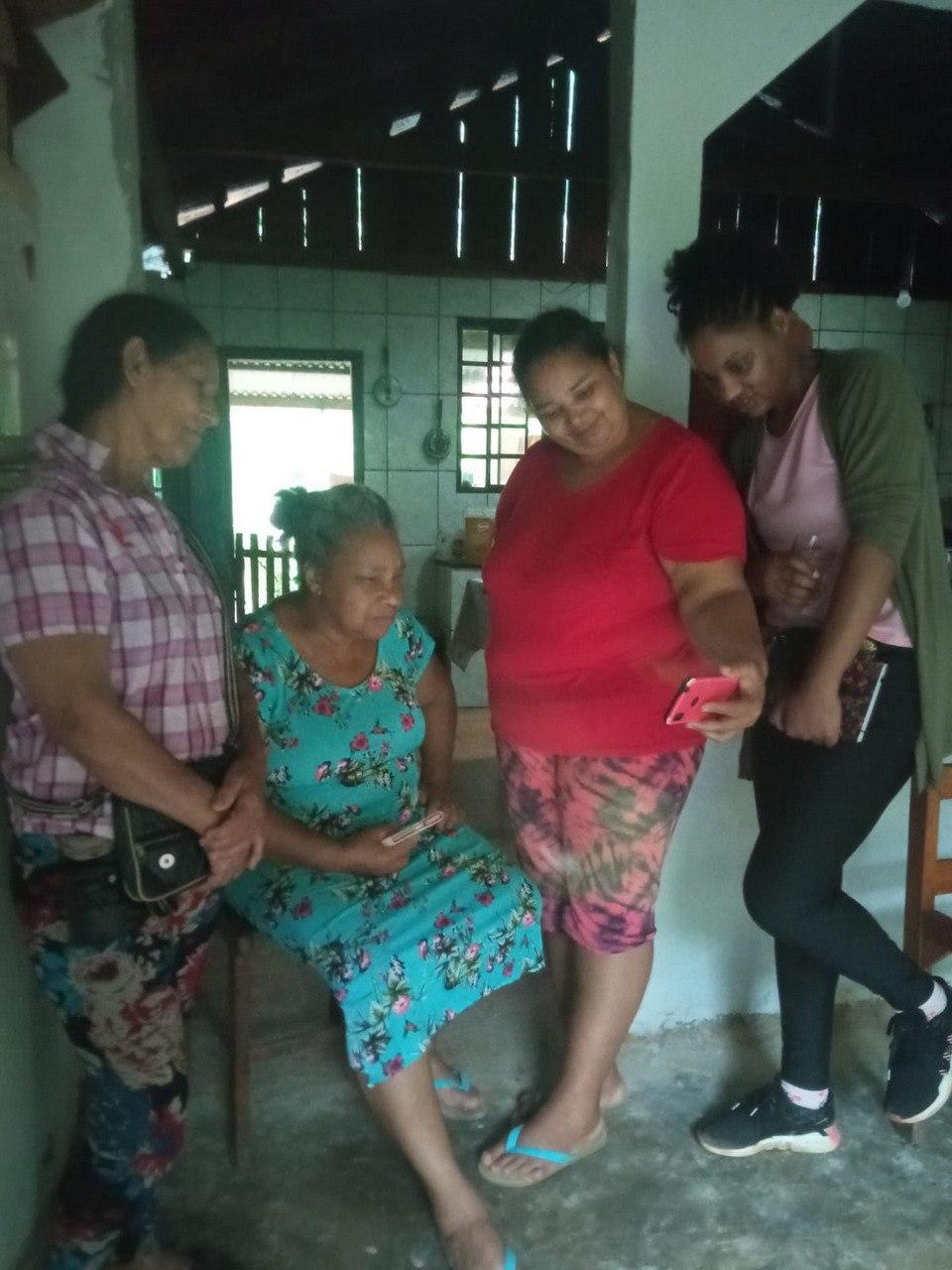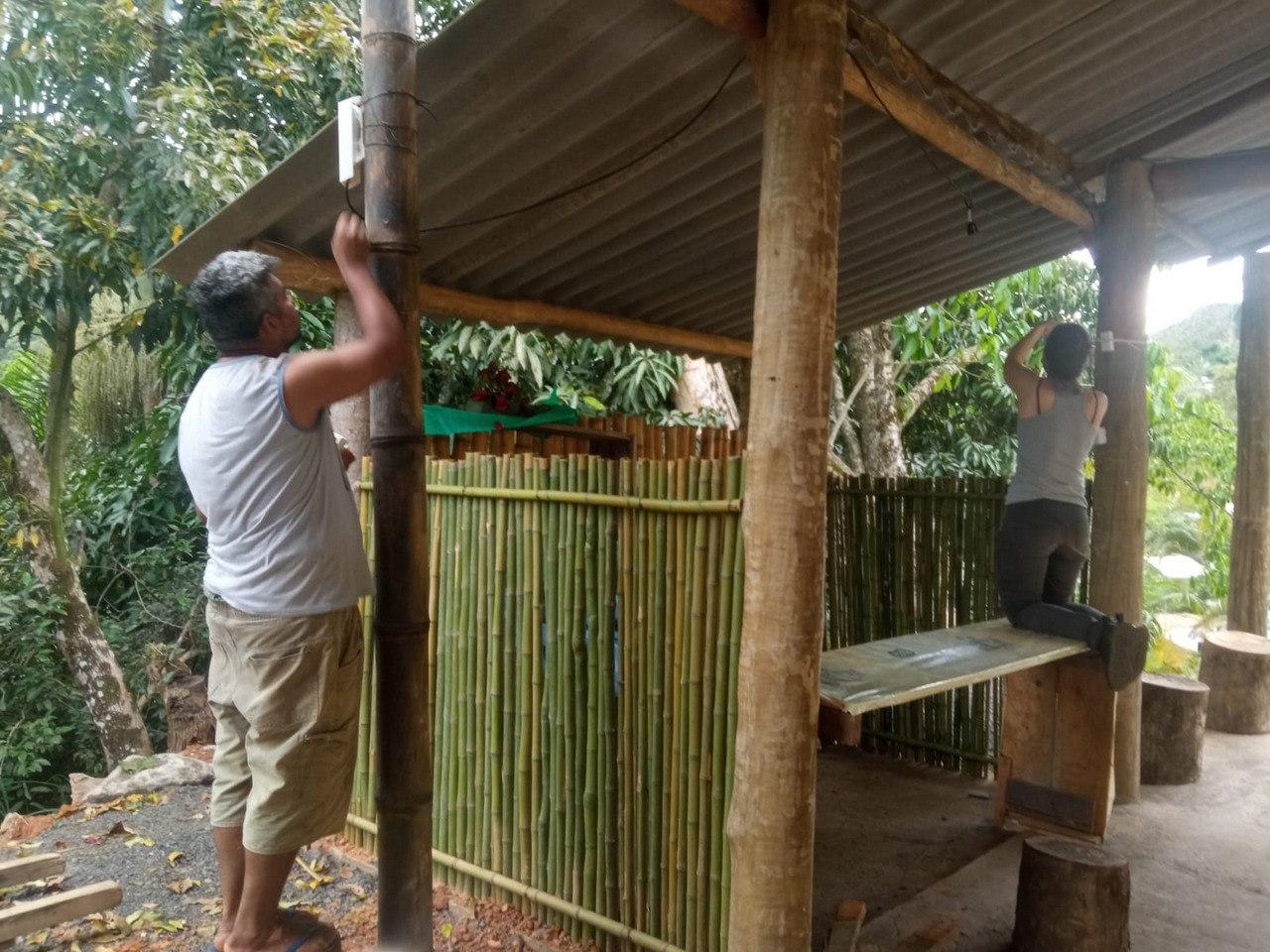
This piece is based on joint discussions and work experience among three community networks in the state of São Paulo in Brazil. Our collective learning on the installation and use of the Pirania captive portal – a LibreMesh application that works as an internet access control tool in community networks – resulted from seeking a solution to a concrete problem.
Since 2019, Sempreviva Organização Feminista (SOF), together with a group of free software activists and the Rede Agroecológica de Mulheres Agricultoras da Barra do Turvo (RAMA), have built a community internet network in a quilombola [1] community in the municipality of Barra do Turvo, in the Vale do Ribeira region of Brazil. The construction of this network started with a feminist political alliance, and the desire to provide a better option for political organisation and consolidation of the processes for marketing foods produced by the local women for the city. The process of designing and installing the community network was fully participatory, involving women farmers and youths from the community in all the work. During the process, workshops were conducted on digital security, network operation and technology, with the aim of empowering individuals in network management and maintenance, as well as creating a training process to enhance the territory’s own forms of knowledge, instead of promoting new (digital) technologies over others.
After a few months, this entire collective process resulted in the installation and full operation of the community network in a large part of the quilombo territory, under the management of women from RAMA and local youth. Over time, new questions came up. One of the greatest challenges that emerged was how to control access by individuals to the network.
The internet service provider in this area is a private company, and this is a reality in many community networks in Brazil, as there are no effective public policies guaranteeing free internet access as a right. It is therefore necessary to pay for internet service on a monthly basis. The women from RAMA started a monthly process of collecting money in the community. Although the service is charged for, the amount divided by the whole community is infinitely more affordable than it would be if each individual took out a contract for internet service which is impossible for most families.
After a few months, the internet password started to be shared between individuals, and many people were able to access the network despite not making a financial contribution. It came to a point where it started to become impossible to collect the money necessary for monthly payment of the internet service, because those who were paying started to feel disinclined to continue their contributions knowing that there were people accessing the network without paying.
As a result of this concrete problem, the women from RAMA sought out the group of activists who conducted the first workshops and continued giving technical support to this community network. One of the possible solutions for this problem is the installation of a “captive portal”: a type of “tollgate” which is installed on the network, where a landing page asks each user to enter an individual password to access the network. As such, it is impossible to share passwords, as each device connects with a unique password. In other words, one person’s access password will not work on somebody else’s device.
Through meetings of the free/libre technology movement, women from the technical community network support group learned from the experience of another community network in which this tool was already in use: the Portal sem Porteiras (PsP) community network in the Monteiro Lobato municipality, as well as in the state of São Paulo in Brazil. However, these women did not know how to operationalise installation and use of a captive portal in practice.

Communities of practice and knowledge exchange
The possibility of participating in a community of practice emerged as an opportunity for exchanging knowledge with other communities.
Communities of practice are groups of individuals who share a common concern, a set of problems or interest in a topic and who meet to achieve individual and collective objectives. Throughout 2022, communities of practice were created by the Local Networks (LocNet) initiative, a collective effort led by APC and Rhizomatica with partners in Africa, Asia, and Latin America and the Caribbean.
One of these communities of practice enabled a process of exchange between the community network of the quilombola community and PsP, also including members of the Casa dos Meninos network, an association acting on the outskirts of São Paulo that was also interested in the Pirania captive portal.
We always believe that training processes are learning opportunities that teach much more than planned, through exchanges of experience and discussions of knowledge. At such times, we follow a principle of always listening to the community on the receiving end of the exchange as the starting point of the process: it is the individuals from the territory who first share how the network is working, how they feel using the network, what problems they have faced and what type of solutions they believe are appropriate. Only afterwards does planning of the collective work start, in the form of opinions and conversations with people from outside (visitors), in order to deal with the territory’s real and concrete needs.
This was the case with our exchanges on Pirania: we listened to the women from RAMA and the youth relating how network usage had been and the problems they had faced, and then the members of the Portal sem Porteiras network explained how Pirania works and the possibilities it could offer to the territory. When the collective conversation concluded that installation of this captive portal was truly a good option to deal with the problem, the portal training process was started to teach everyone about installation and operationalisation.
In addition, the presence of individuals with technical knowledge from outside the territory was an opportunity to optimise other aspects of the community network. We helped in exchanging the necessary equipment, changing the internet service provider, and expanding the territorial reach of the network through installation of new antennas.
After the installation of the captive portal, the women and youth from RAMA kept in touch with the activists from PsP and Casa dos Meninos via the community network internet, reporting problems and raising doubts remotely, which was essential for consolidation of the process, without letting problems (which will always occur) stop the community from their continued use of the captive portal.

Sharing of cultivated knowledge
This entire process was documented and became the manual “How to use Pirania? Lessons from real use on community networks”, in which we provide more details on our teaching process and share tutorials which explain step-by-step how to handle the main functions and settings of the captive portal.
Apart from visits to Barra do Turvo, we also conducted visits and workshops involving activists from PsP and Casa dos Meninos at the PsP headquarters in Monteiro Lobato and conversation circles in São Paulo, to enable further exchanges of experience on the operation and management of community networks. In all workshops and collective spaces, we proposed viewing the networks and our work with technology in a feminist, non-racist manner. This started with always planning and executing the activities so that they would be appropriate for the level of experience and time available of all individuals.
In one of our workshops, for example, a group of young men from the territory formed a small group in the space and started raising their doubts with one of our technicians (also men) from the Portal sem Porteiras network. In this small space within the general workshop space, they started to talk and learn about the network more quickly than the general pace of the group, given that they were already more familiar with the equipment than the women who were in the workshop. At that time, we decided to ask the group to break up and to demonstrate the settings they were tinkering with on one of the young men’s mobile phones, on a computer linked to the projector. In this way, everybody managed to see the procedure that they were working on through the image projected on the wall, and they were encouraged to ask questions.
Actions like this are an example of how to guarantee that everybody, irrespective of their level of previous knowledge and their relationship with technology, feels part of the process. There is a lesson that we always share in our agroecology training, and that we extrapolate to all training processes, and that is that our learning group must move at the pace of the person at the earliest learning stage.
As a result, we might take longer to reach the final destination, but we will arrive together, side by side, which will certainly have an impact on the level of autonomy that groups which are historically and socially used to being excluded from digital technology and that are the most impacted due to inequality of access, such as women and Black people in Brazil, will then have on the technical and political processes of the community network.
[1] Quilombos emerged as refuges for Black people who escaped repression during the entire period of slavery in Brazil, between the 16th and 19th centuries. The inhabitants of these communities are called quilombolas. After abolition, most of them preferred to continue living in the villages they had formed. Today Brazil has more than 15,000 quilombola communities. Source: https://www.genderit.org/feminist-talk/contribution-bell-hooks-and-paulo-freire-construction-community-networks